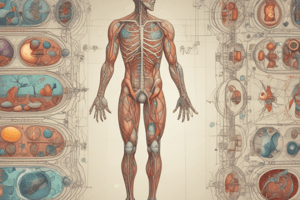Podcast
Questions and Answers
Homeostasis is the process of keeping the internal environment constant.
Homeostasis is the process of keeping the internal environment constant.
True (A)
Positive feedback mechanism is a self-control system where the resultant response enhances the stimulus.
Positive feedback mechanism is a self-control system where the resultant response enhances the stimulus.
True (A)
Negative feedback mechanism is the most common form of homeostatic control.
Negative feedback mechanism is the most common form of homeostatic control.
True (A)
Obligatory water reabsorption depends on antidiuretic hormone (ADH).
Obligatory water reabsorption depends on antidiuretic hormone (ADH).
Simple diffusion requires additional energy for molecules to move from an area of low concentration to high concentration.
Simple diffusion requires additional energy for molecules to move from an area of low concentration to high concentration.
Study Notes
Homeostasis
- Maintains a stable internal environment despite changing external conditions.
- Essential for the proper functioning of cells and overall organismal health.
Positive Feedback Mechanism
- Functions as a self-regulating system that amplifies the initial stimulus.
- The resulting effect enhances or stimulates the original signal, moving in the same direction.
- Common examples include childbirth (oxytocin release) and blood clotting.
Negative Feedback Mechanism
- A self-regulating system that counteracts the initial stimulus to maintain balance.
- The resulting response opposes the stimulus, promoting stability.
- Most prevalent method for homeostatic control, involving mechanisms like temperature regulation.
Obligatory Water Reabsorption
- Occurs in the proximal tubules of the kidneys, reabsorbing approximately 65% of water.
- The process is linked to sodium reabsorption but operates independently of hormonal influence.
- Crucial for ensuring adequate hydration and electrolyte balance.
Facultative Water Reabsorption
- Takes place in the distal tubules and collecting ducts of the kidneys, reabsorbing about 25% of water.
- Independent of sodium reabsorption; regulated by antidiuretic hormone (ADH).
- Vital for fine-tuning water balance in response to the body's hydration needs.
Simple Diffusion
- The movement of molecules occurs from high to low concentration areas without energy input.
- A passive transport mechanism essential for nutrient absorption and molecule elimination.
- Important for processes like gas exchange in lungs and cellular transport.
Studying That Suits You
Use AI to generate personalized quizzes and flashcards to suit your learning preferences.
Description
Test your knowledge of homeostasis, positive feedback mechanisms, and negative feedback mechanisms with this quiz. Challenge yourself with questions on how the body maintains internal balance and regulates physiological processes through these control mechanisms.




